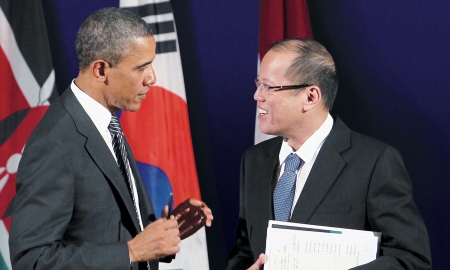The current President of the Philippines Benigno S. Aquino III, son of well-loved former president Corazon Aquino, has been steadfast in his campaign to serve his real “boss”, the people of the Philippines. Curtailed corruption, improved transparency, economic growth, welfare programs, peace talks with local rebel groups, job creation, and infrastructure development are key points on the agenda that President Aquino has actively pursued since being elected in 2010.
After years of practically uncontrolled corruption in the Philippines, he certainly has his work set out for him; however, he views corruption eradication as key to solving another pressing problem.
“I was put into office by the people who believed in my idea that corruption is the root of poverty; that an end to corruption would mean an end to poverty,” he said in 2010.
A few months later, he expanded on this idea, saying: “The time for patronage is over. Now is the age of professionalism, meritocracy, and government institutions that are committed to the people… We will leave a country less poor, easier to invest in, and where people trust their government and all of its entities to work for their interests.”
Perhaps due to its recent instability, the Philippines has lagged behind its neighbors in terms of foreign investment. From 2000 to 2011, FDI only totaled $25.59 billion. In contrast, Malaysia attracted $114.56 billion and Thailand, $146.12 billion. Nevertheless, this is set to change owing to the country having achieved two investment grades from Fitch Ratings and Standard & Poor’s – a sign that President Aquino’s efforts are paying off.
GDP growth has been in the black throughout his term, with 7.6% in 2010, 3.9% in 2011 and again a strong 6.6% last year (placing it at the forefront of economic growth in Southeast Asia). The economy has remained strong throughout the global recession, mainly due to its low dependence on exports, its huge remittances from 4 to 5 million overseas Filipino workers that in turn lead to strong domestic consumption, a rapidly expanding business process outsourcing (BPO) industry, and minimal exposure to troubled international securities.
Presently, the Philippines’ economy is the world’s 46th largest. By 2018 it’s forecasted to rank 31st.
Not all is rosy, however. Unemployment stands at 7%, while underemployment in almost 20%. Moreover, it’s estimated that over 40% of employed Filipinos work in the informal sector. And with a median age of 22, the working-age population is growing at a rapid rate, while job creation remains low still.
The Aquino administration has earmarked large sums for infrastructure (an area it would like to see further developed under the public-private partnership program) as well as for social programs, namely in health and education.
One of the government’s most successful social protection schemes to date is Pantawid Pamilya, or Family Subsistence, piloted in 2007. Currently, 3 million poor households receive small monthly grants for keeping their children healthy and enroled in school.
President Aquino and his “boss” have much to celebrate despite the ongoing challenges inherent in a fast-growing emerging market economy. In July 2012, he illustrated his administration’s success.
“These past two years, we have proven that, as a nation, we can make possible what was once thought of as impossible. For example, at a time when economies all around the world face great uncertainty, ours thrives. Both the investor market and our people are working with a newfound confidence that has led us from success to success. And we have done this despite the significant deficit we inherited, and without raising taxes.
“These past two years, we have also breathed new life into the idea that government is there to work for its people. We have focused on fulfilling our mandate to uplift the common Filipino by spending significant portions of our budget on social services – most prominently our Pantawid Pamilya Program, which is helping 3 million households from sinking further into poverty, and is giving them the resources to lift themselves out of their situations. We are giving their children the chance at proper education. We are requiring them to see medical professionals for regular check-ups. In short, government is finally giving our people what they rightfully deserve.”

0 COMMENTS